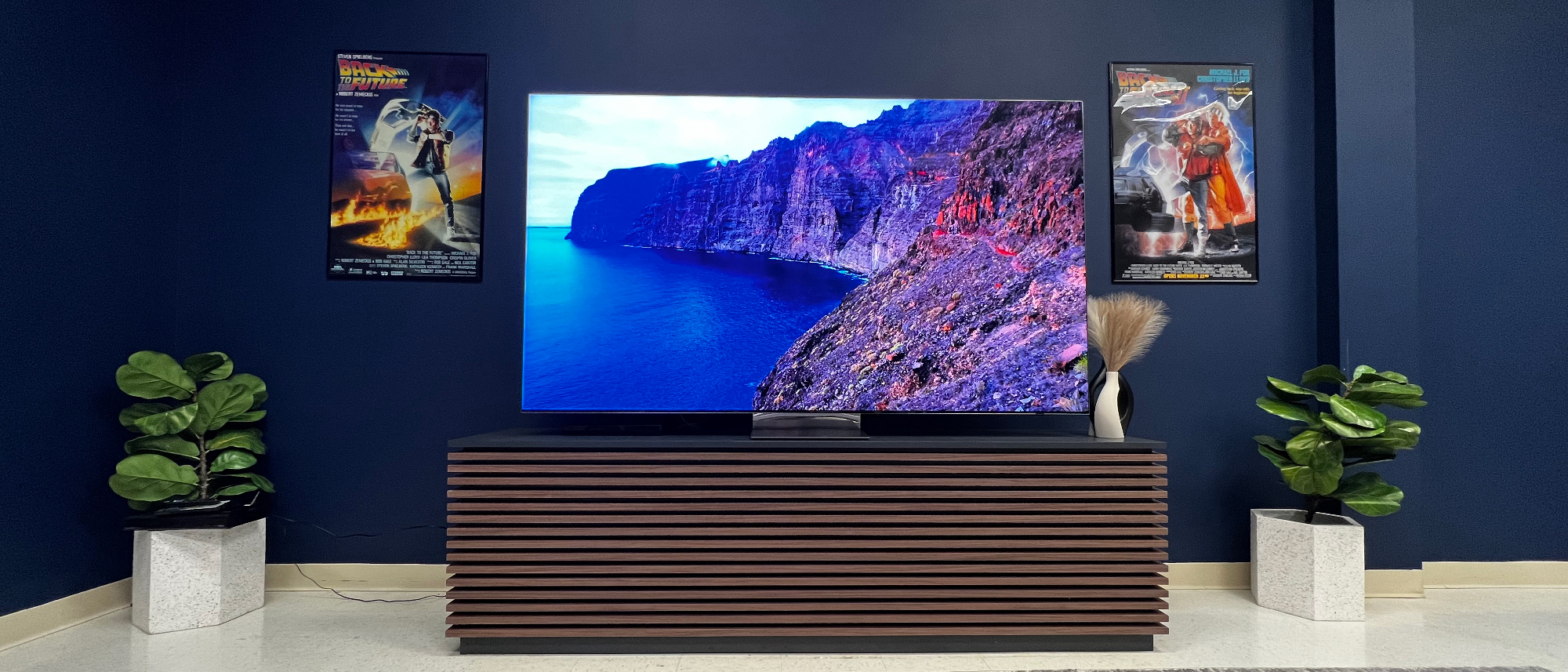Tom's Guide Verdict
Samsung's QN900D Neo QLED 8K TV is an outstanding television that delivers cutting-edge AI upscaling features, fantastic picture quality and an improved interface, along with an unrivaled design. Its lack of Dolby Vision support is unfortunate, but everything else about the QN900D is batting a thousand.
Pros
- +
Excellent upscaling
- +
Outstanding brightness
- +
Improved Tizen OS
- +
One Connect box returns
Cons
- -
Still no Dolby Vision
- -
AI enhancements not for everyone
Why you can trust Tom's Guide
Samsung's QN900D Neo QLED 8K TV is the South Korean electronics giant's flagship television for 2024, and it's undoubtedly the most premium TV it has produced to date, sporting a stunning new design, a number of OS refinements, and a third-gen AI-powered processor.
However, like last year's excellent QN900C, the QN900D arrives in a world which continues to debate whether 8K TVs are worth investing in. Many will argue that native 8K content is practically non-existent at present, making support for 8K resolution completely superfluous.
On the flip side, there are those who see the benefits of upscaling on larger displays, and don't actually care whether the content they're viewing is being rendered in its native resolution.
Those in the latter camp will be pleased to learn that Samsung's QN900D has upped the ante when it comes to upscaling, going all in on AI in an attempt to wrestle that particular crown from Sony (of course, we'll need more time with the Sony Bravia 9 to see how things shake out).
Obviously, the QN900D won't be for everyone. For starters, 8K resolution comes with a big jump in price which many won't be able to justify. And if you were hoping that Samsung would finally bring Dolby Vision support to this year's flagship TV, you're going to have to keep waiting.
Still, our time with the Samsung QN900D Neo QLED 8K TV has us convinced that it's not only Samsung's best TV of the year, but one of the best TVs of 2024.
Samsung QN900D Neo QLED 8K TV review: Price and availability
Given that the QN900D is Samsung's flagship TV of 2024, it comes as no surprise that it carries an equally premium price tag. What does surprise us, however, is that its pricing has remained largely the same as last year's QN900C (with the exception of the UK and Australia, where it's a little more expensive for the larger sizes).
Get instant access to breaking news, the hottest reviews, great deals and helpful tips.
The QN900D starts at $4,999 / £4,999 / AU$6,499 for the 65-inch model, before moving up to $6,299 / £6,499 / AU$8,999 for the 75-inch model, and topping out $7,999 / £9,499 / AU$11,999 for the 85-inch behemoth, which is what we tested. However, you could potentially bring the price down by using one of our Samsung discount codes.
- Samsung QN900D 65-inch: $4,999 / £4,999 / AU$6,499
- Samsung QN900D 75-inch: $6,299 / £6,799 / AU$8,499
- Samsung QN900D 85-inch: $7,999 / £9,499 / AU$11,999
Samsung QN900D Neo QLED 8K TV review: Design
For the last few years, Samsung's flagship televisions have been unrivaled in terms of design, and the QN900D continues that tradition by being the South Korean electronics giant's most beautiful TV yet.
Boasting a new 'Infinity Air Design', the QN900D once again sports a practically non-existent bezel (we're talking 1.2mm on the top and sides, and 8.1mm at the bottom). However, Samsung takes things a step further this year with a new mirrored pedestal stand which makes the display look like it's floating, giving it even more of an all-screen appearance.
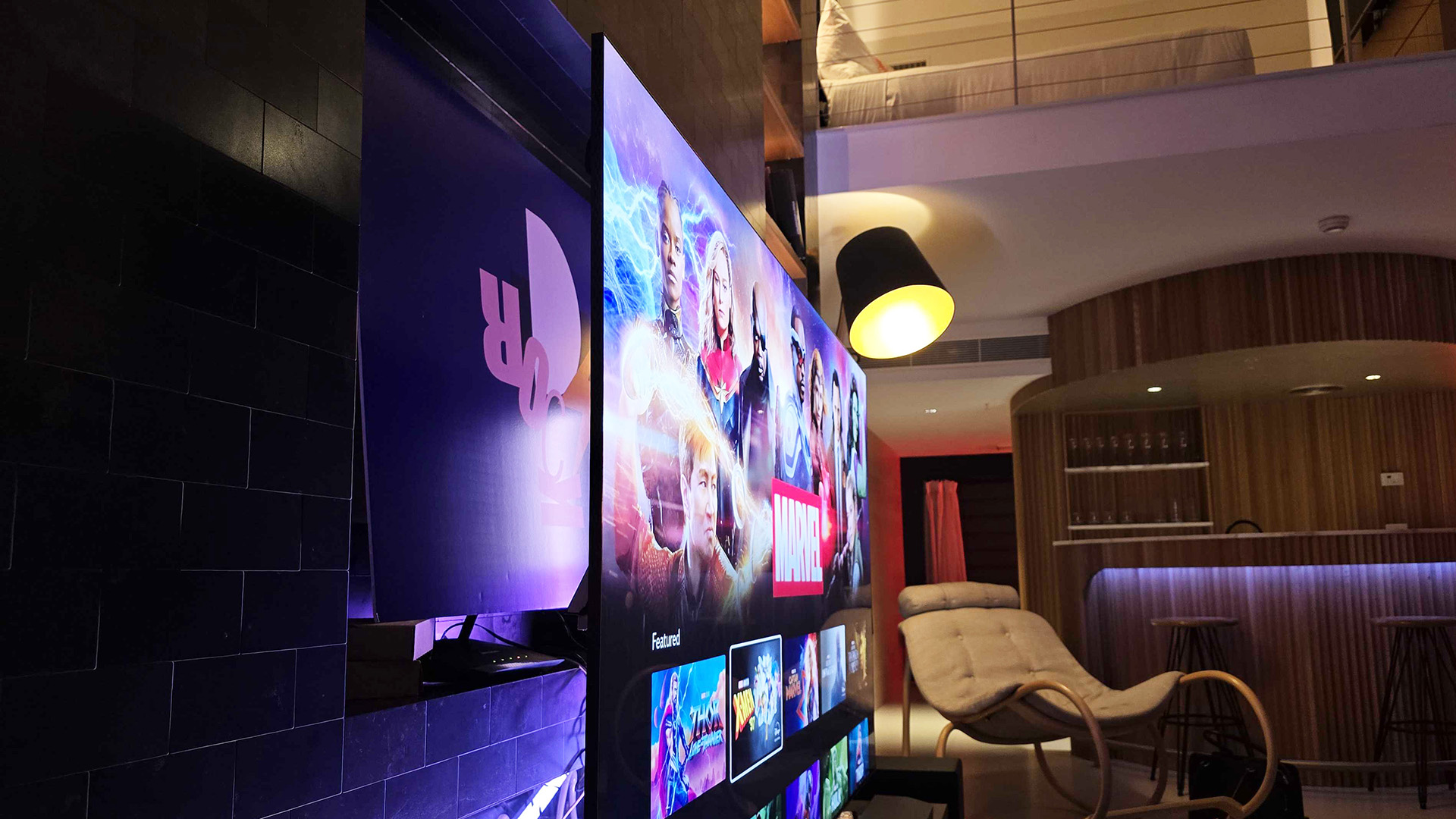
We're also pleased to see the return of Samsung's brilliant One Connect Box — a detachable media receiver that holds all of the QN900D's various inputs and acts as the TV's power supply.
The box itself can be mounted on the back of the QN900D's pedestal stand, or tucked away in a nearby entertainment cabinet for easy access to its four HDMI 2.1 ports (one of which supports eARC) and other connections (RF input, USB ports, Ethernet port and Optical audio out). All of the inputs are then fed through to the screen via a single cable — that means only one cord to hide when wall mounting.
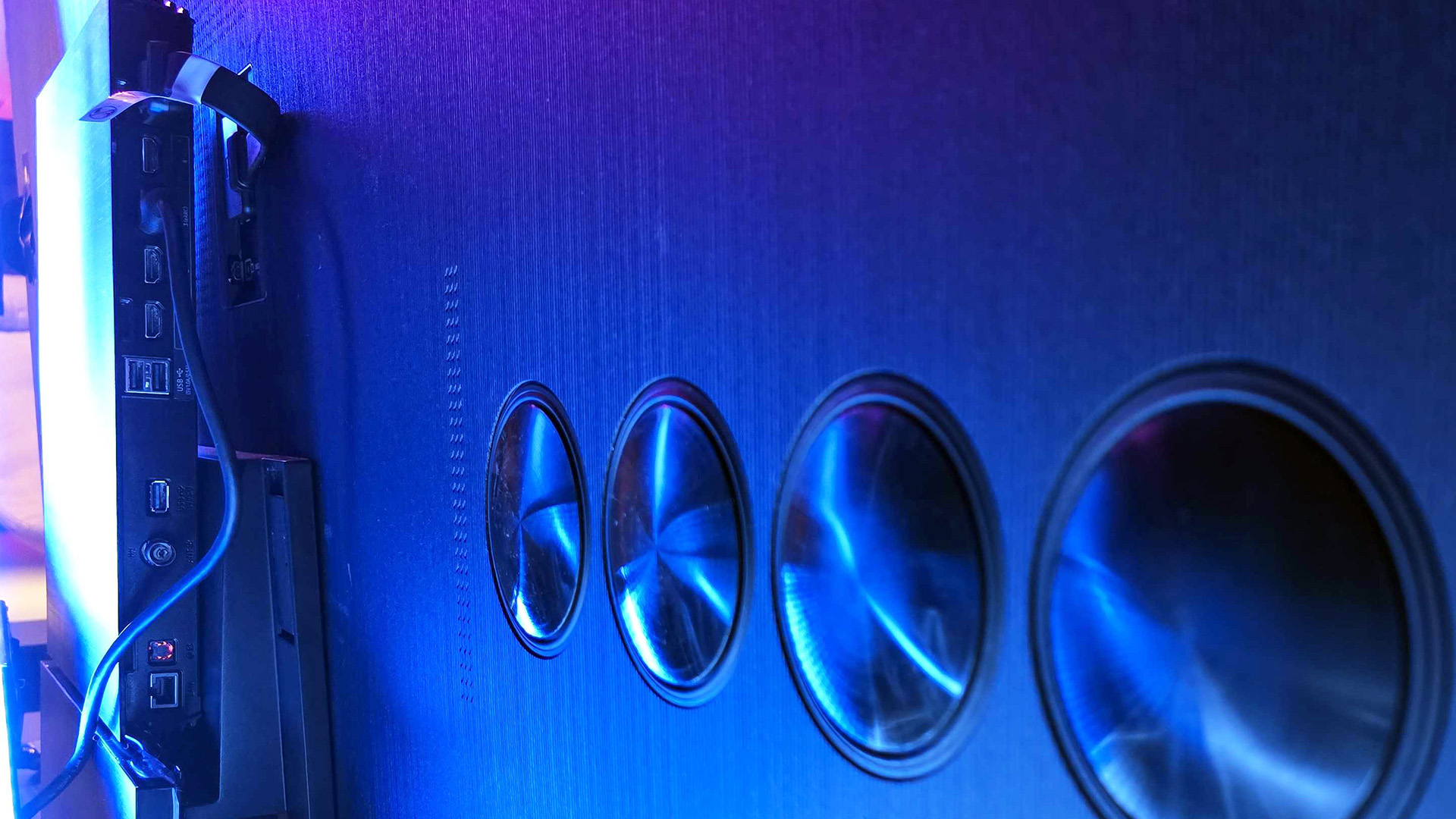
With the Infinity Air Stand attached, the 85-inch model we tested measures 73.9 x 42 x 12 inches (1877.4 x 1067.1 x 304.9mm). Without the stand, the screen itself measures just 0.5 inches (13.3mm), which is still remarkably thin for a TV with Mini LED backlighting behind its display.
And, as with previous Neo QLED flagships, the QN900D has speaker grilles along the top and sides of its display, which is one less thing distracting viewers from its practically borderless screen.
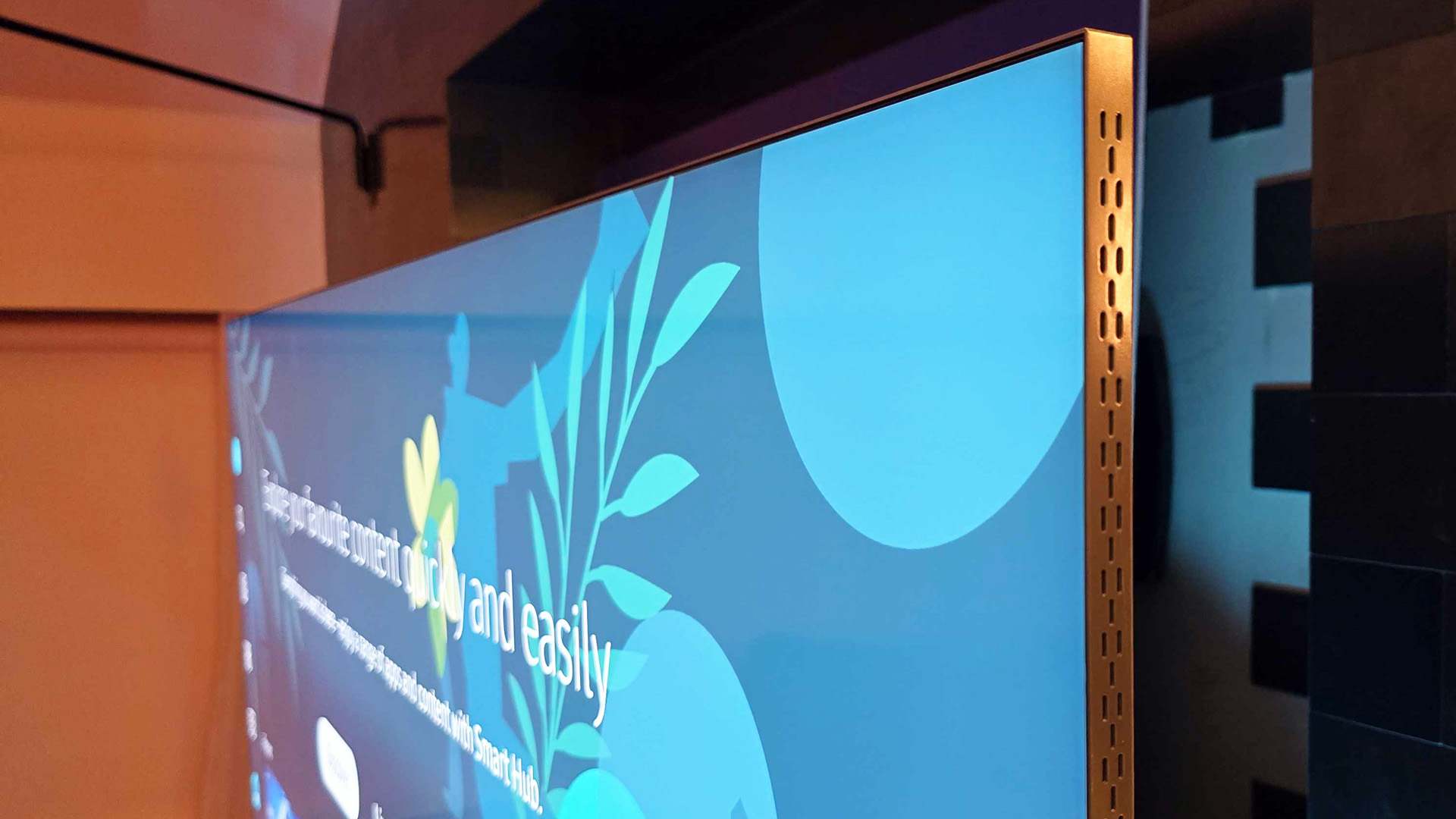
Samsung QN900D Neo QLED 8K TV review: Performance
This year, the big selling point for Samsung's latest flagship is its 8K AI Upscaling Pro functionality, powered by the new NQ8 AI Gen 3 Processor. As the name suggests, the feature takes advantage of AI neural networks to enhance the TV's image quality on the fly. That means sharper detail and increased clarity for content that falls below 8K native resolution (i.e. almost all content).
While this technology isn't new for Samsung, having been deployed on the manufacturer's previous flagship TV, it has been drastically beefed up this year. According to Samsung, the QN900D's 8K AI upscaling makes use of 512 neural networks — eight times the number used by the QN900C.
At default settings, the QN900D's AI upscaling resulted in the noticeable reduction of noise and artifacting in the TV's Standard and Dynamic picture modes, while color, brightness and motion smoothing all received a huge boost, occasionally venturing into unnatural territory.

While the AI-tweaked colors and showroom-ready image clarity will surely result in many, many televisions sold, they're at odds with the wants of A/V purists, who are more concerned with accuracy and the original intentions of filmmakers than ever before — even film grain is being wholeheartedly embraced these days.
Thankfully, the QN900D still offers Movie and Filmmaker Mode settings, meaning cinephiles can completely avoid all the neural network tweaking if they want to. On top of this, Samsung's handy Smart Calibration tool is still available via the SmartThings app, allowing you to optimize your Movie Mode to near-professional standards within minutes. We absolutely recommend doing this, as the default values in Movie Mode are somewhat dull right out of the box.
The two shots below from Saving Private Ryan illustrate the difference between Dynamic and Filmmaker Mode at default settings. Notice how the teals and reds of the scene are blown out to near neon levels of saturation.
As for general performance, it will come as no surprise that the QN900D's Mini LEDs offer incredible brightness and improved backlight control, resulting in excellent contrast while exhibiting even less light bleed than its predecessor.
When we reviewed Samsung's QN900C last year, we noted that it boasted the highest peak brightness of any TV we'd reviewed in recent memory. This time around, the QN900D can't quite make that claim — that honor goes to the Hisense UX, which broke every possible test metric at CES 2024.
Before you start worrying, you should know that Samsung's Mini LED-sporting QN900D is still astoundingly bright, reaching a peak luminance of 2,338 nits in a 10% window, putting it well above high-end OLED TVs like the LG C4 (1,049 nits) and even Samsung's own S95D (1,777 nits).
If there's one area where Samsung's QN900D disappoints, it's the TV's lack of Dolby Vision support. We understand that Samsung would rather promote HDR10+ given its hand in creating the standard, but there's no denying that Dolby Vision's 12-bit color is technically superior, on top of being widely preferred by videophiles. Given that Samsung is the number one TV manufacturer in the world, it feels almost silly that its flagship television still doesn't support Dolby Vision.

Of course, the real measure of quality for many will come down to how the QN900D handles color, and on that front, Samsung's flagship is remarkably impressive.
Once again, this quantum dot-sporting Neo QLED TV delivers seriously vibrant color saturation, reaching 99.83% of the Rec. 709 color gamut in Filmmaker Mode for SDR content (compared to last year's 99.13%), while HDR content reaches 94.6% coverage of the UHDA-P3 Color Gamut (compared to 93.04% on the QN900C).
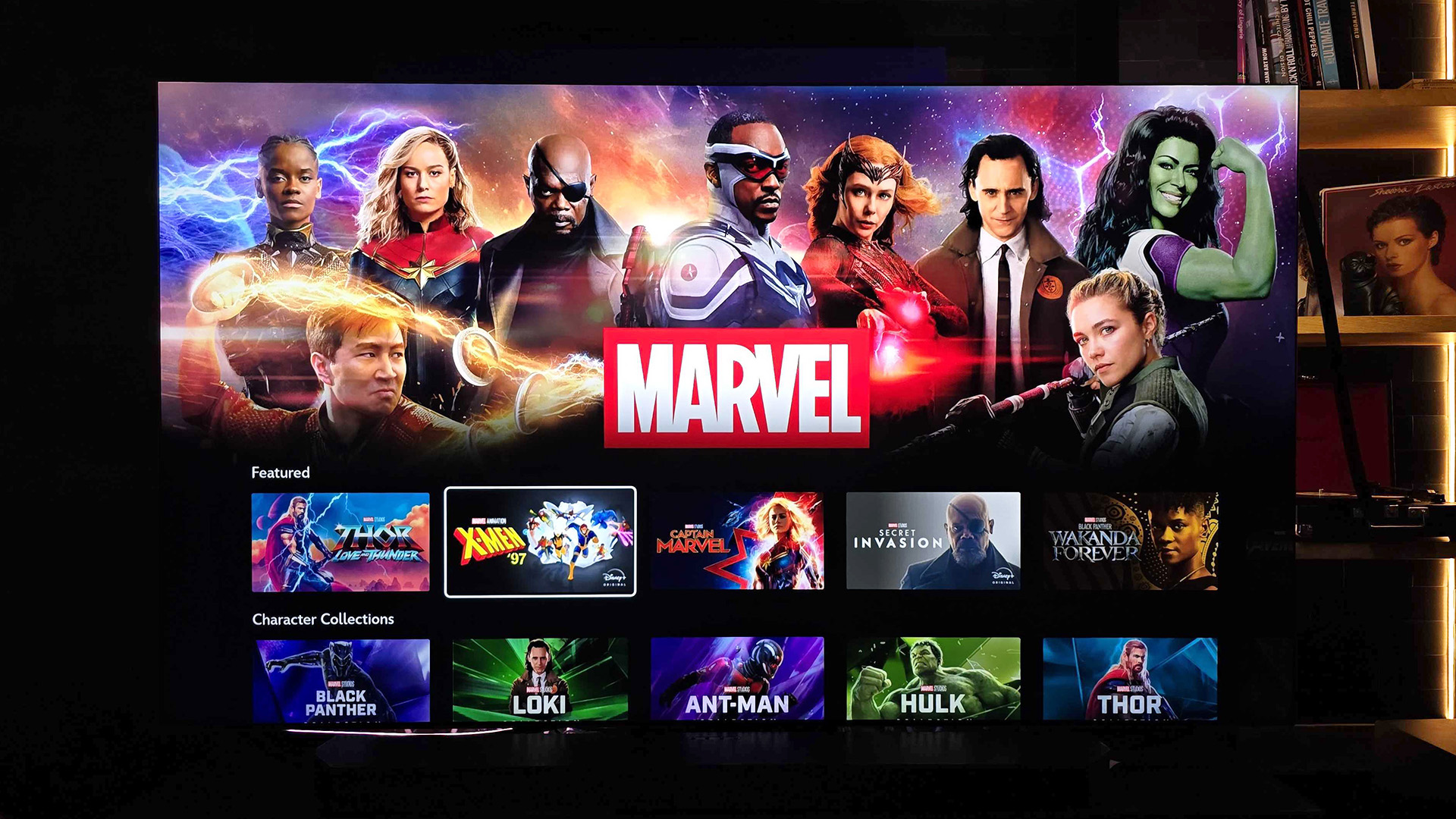
Color accuracy on the QN900D is also excellent, measuring 1.8413 in our Delta-E test, where lower numbers are favored. That's a significant improvement on last year's flagship, which measured 2.8686, putting the QN900D on a similar playing field as LG's C4 OLED, which measured 1.8201.
For more see how we test and review TVs.
Samsung QN900D Neo QLED 8K TV review: Audio
Along with its image upscaling prowess, the QN900D's AI processing also extends to sound, where a new AI-powered dialogue booster called Active Voice Amplifier Pro uses deep-learning to make dialogue more pronounced.
Samsung's Adaptive Sound Pro technology has also received an AI upgrade, taking advantage of neural processing to analyze and remaster sound objects on a scene-by-scene basis, resulting in improved clarity and audio balance.
Just like last year's model, the QN900D sports a 6.2.4-channel system with 12 embedded multi-directional speakers in total, delivering a 90W output. Along the top edge of the QN900D is an array of up-firing speakers, qualifying it for true Dolby Atmos, even if the level of immersion is on the minimal side — especially when compared to a soundbar.
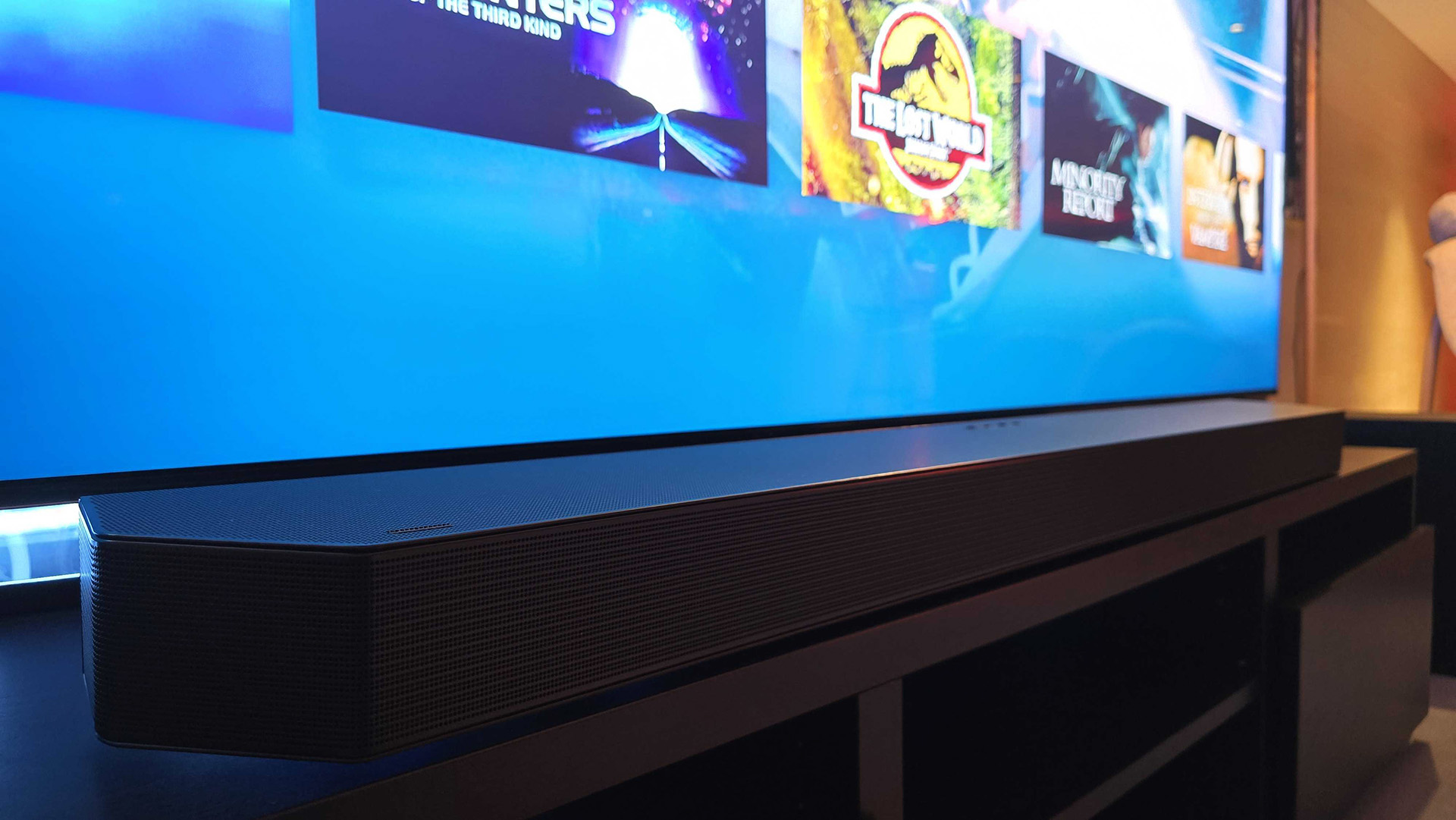
Speaking of soundbars, the QN900D supports Samsung's Q-Symphony technology, allowing the TV and its speakers to perfectly sync up with compatible soundbar models, resulting in a more pronounced center channel for dialogue. We tested Q-Symphony using Samsung's new Q990D Q Series soundbar and heard a significant lift in dialogue level.
The feature is also said to work with Samsung's new Music Frame, theoretically giving users additional speakers for a beefed up surround experience, though we didn't get around to testing this for ourselves.
Additionally, the QN900D supports wireless Dolby Atmos with compatible Q Series soundbars like the one mentioned above, meaning one less HDMI cable coming from your One Connect Box.
Samsung QN900D Neo QLED 8K TV review: Gaming
As with previous Samsung Neo QLED TVs, the QN900D is a gamer's dream television, delivering full HDMI 2.1 support for 4K/120fps gaming on PS5 and Xbox Series X consoles on all four HDMI ports. That also means support for variable refresh rates (VRR) and auto low-latency mode (ALLM).
As with image and audio quality, gaming also gets an AI boost on the QN900D, with a new AI Auto Game Mode which provides automatic setting optimization. It's said that the AI engine is smart enough to recognize the game you're playing and automatically adjust picture and sound quality for an optimal experience. We tried the feature out with Forza Horizon 5 and the game looked quite stunning to our eyes, with great contrast levels during night time racing.
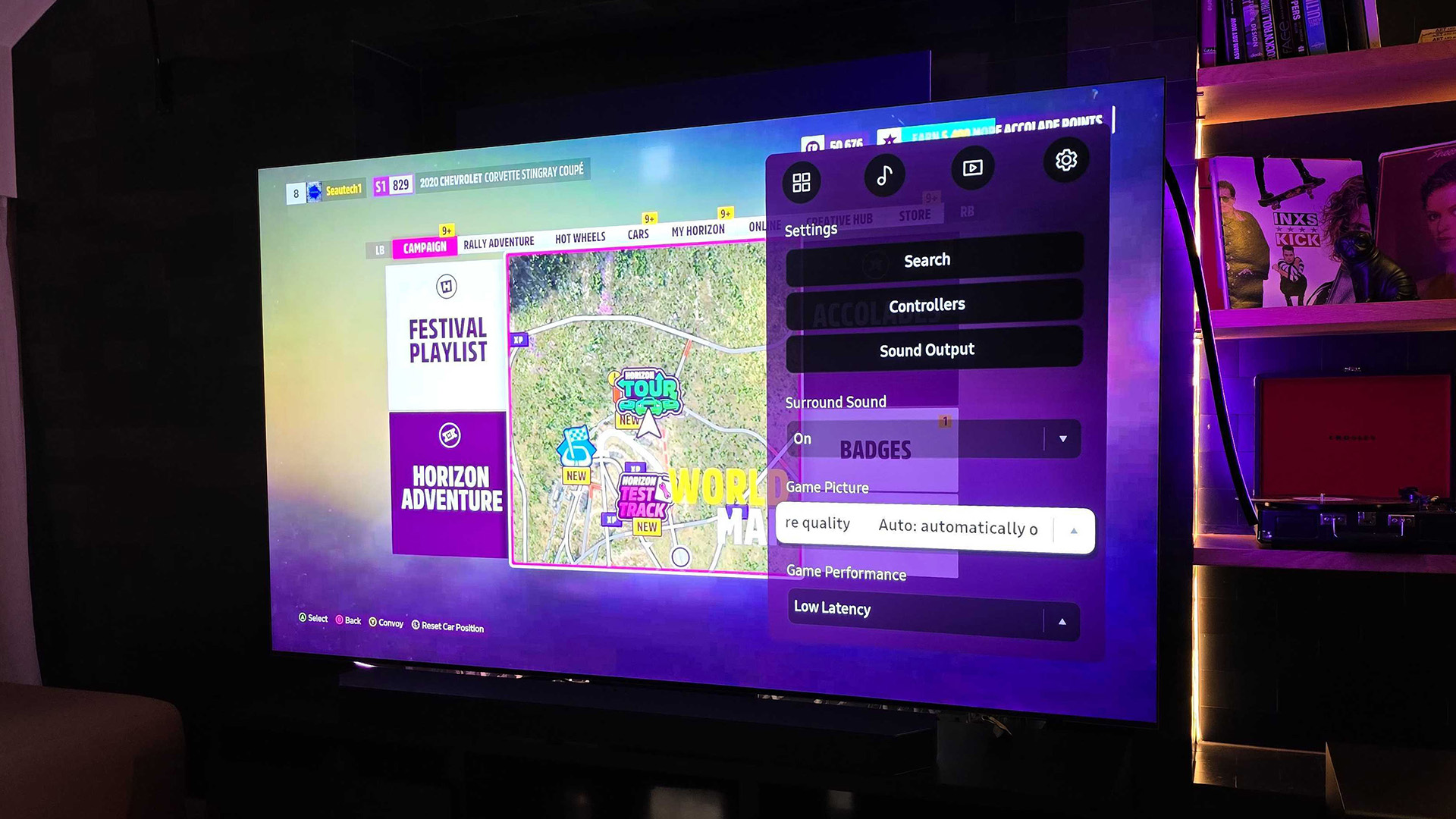
Samsung's Gaming Hub also returns, giving players quick access to Game Mode settings, such as Game Motion Plus, Game Picture Mode, an FPS counter and more. FreeSync Premium is also supported, so PC gamers can play at refresh rates of 144Hz without worrying about screen tearing or dropped frames.
As for latency, our 4K Leo Bodnar Signal Lag Tester recorded 10.4 milliseconds of input lag from the QN900D with Game Mode enabled, which is slightly up from last year's model, which recorded 9.6 milliseconds.
Samsung QN900D Neo QLED 8K TV review: Interface and apps
Samsung has given its Tizen smart TV platform a slight refresh on the QN900D, with a focus on discovery and making it easier to resume shows and movies you've already started watching.
Pressing the home button will still bring up the home screen, though instead of going straight to your row of installed apps, you now get three tabs: Discover, Live and Apps. Discover provides you with a wealth of content suggestions, while Live shows you what's currently streaming on a selection of channels from Samsung TV Plus. And, as the name would suggest, Apps takes you directly to your Apps section.
By default, your home screen journey starts on a content row that keeps track of what you've been watching in a new 'Recent' section, which is immediately followed by 'Suggestions'. While this does add an additional step for those who just want to quickly switch apps, the new row does prove rather helpful.
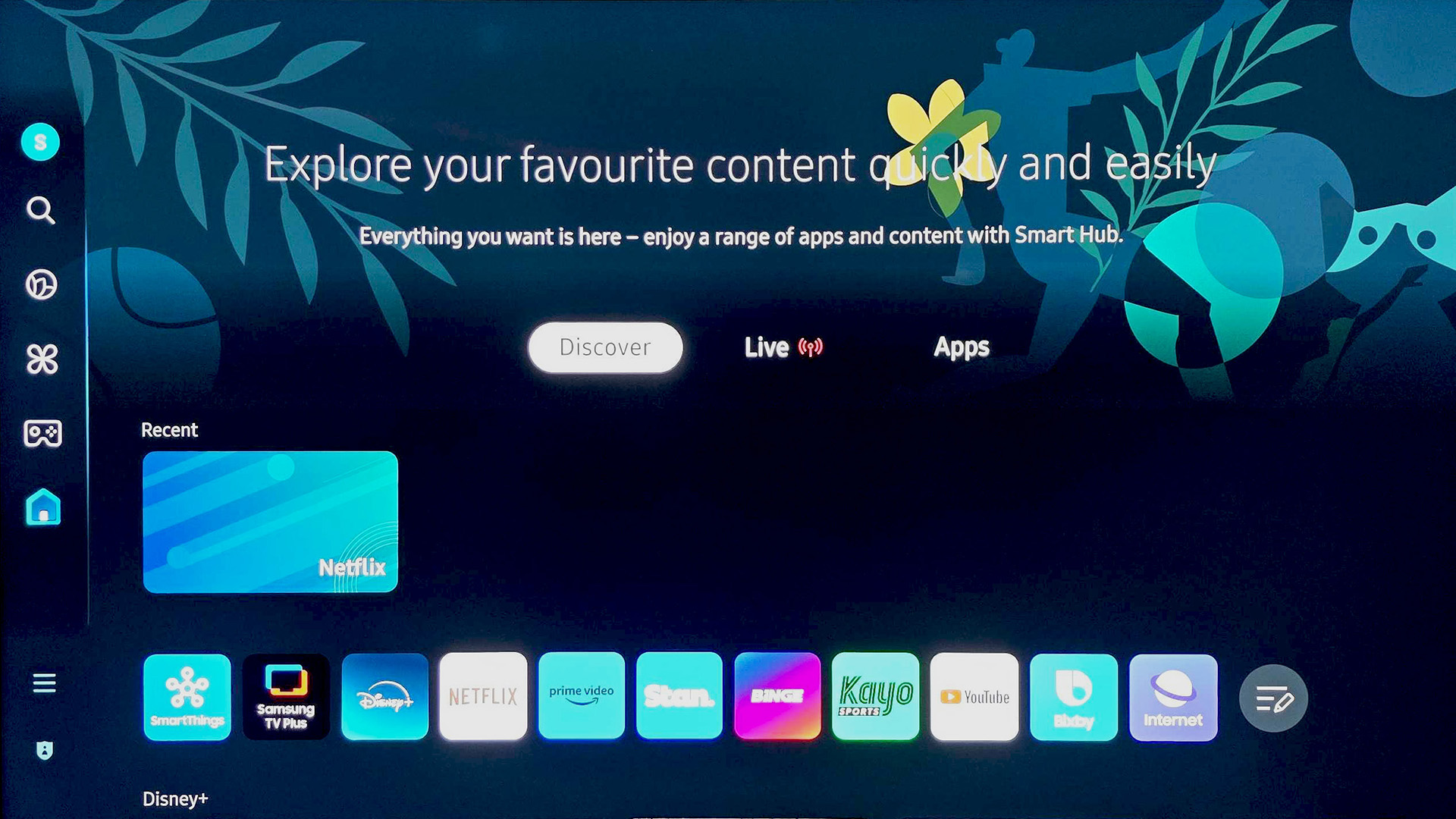
Additionally, the refreshed Tizen OS sees the introduction of accounts, so multiple users can have their own personalized home screen experience. In theory, this will provide a better selection of suggested shows and movies on the home screen that will be more tailored to individual users.
Samsung QN900D Neo QLED 8K TV review: Remote
Due to the early nature of our review period, we were provided with one of Samsung's white universal TV remotes in place of the final release remote. However, our US-based staff writer Ryan Epps was able to try out the proper remote during a different hands-on session and can confirm it remains relatively unchanged from last year's model.
That means the remote once again gets its power from a small rear solar panel that absorbs light (both natural and artificial) to charge an internal battery and keep it going for a much longer time. And if you need faster charging, it also has a USB-C port.

If you've used a Samsung TV remote in the last few years, you'll know what to expect with the QN900D. The remote is small, lightweight and minimalist, with a circular directional pad for navigation.
You also get volume and channel rockers, a selection of function buttons (back, home, play/pause), a settings button, a mic button for voice commands, and dedicated buttons for launching Netflix, Samsung TV Plus, Disney Plus and Prime Video.
Samsung QN900D Neo QLED 8K TV review: Verdict
Samsung has pulled out all the stops for its QN900D Neo QLED 8K TV, delivering its most premium television to date. Boasting advanced AI-driven features, the QN900D delivers stunning picture quality and excellent audio.
Contrast is also exceptional on the QN900D, with its Mini LEDs striking the right balance between remarkable brightness and near-OLED black levels. It's also a brilliant TV for gamers, thanks to its suite of game-centric features and full HDMI 2.1 support.
While not everyone will appreciate the AI-powered upscaling on offer, purists can continue to watch their favorite films as they were intended with Movie and Filmmaker Mode. Aside from the continued omission of Dolby Vision support, it's hard to fault Samsung's QN900D Neo QLED 8K TV, as it's one of the best TVs the company has delivered yet.

Stephen Lambrechts is the Managing Editor of Tom's Guide AU and has written professionally across the categories of tech, film, television and gaming for the last 15 years. Before Tom's Guide, he spent several years as a Senior Journalist at TechRadar, had a brief stint as Editor in Chief at Official Xbox Magazine Australia, and has written for such publications as APC, TechLife Australia, T3, FilmInk, AskMen, Daily Telegraph and IGN. He's an expert when it comes to smartphones, TVs, gaming and streaming. In his spare time, he enjoys watching obscure horror movies on physical media, keeping an eye on the latest retro sneaker releases and listening to vinyl. Occasionally, he also indulges in other non-hipster stuff, like hiking.
